- You are here:
- Home »
- Email Marketing
Category Archives for Email Marketing

Role of Newsletters for Writers: Complete Guide
More than 80 percent of writers say email newsletters are their top way to connect with readers. As inboxes become the new front row for creative voices, newsletters offer something social media cannot: direct, personal communication that cuts through the noise. Writers are finding fresh ways to build devoted audiences, share exclusive content, and shape their brand—all while staying in control of their message.
Key Takeaways
| Point | Details |
|---|---|
| Direct Communication | Newsletters enable authors to reach their audience directly, enhancing personal engagement and brand loyalty. |
| Community Building | Newsletters foster interactive relationships, transforming readers into active community members through consistent, authentic communication. |
| Monetization Opportunities | Authors can leverage newsletters for income through various strategies such as paid subscriptions, sponsorships, and affiliate marketing. |
| Avoid Common Mistakes | Effective newsletters require compelling subject lines, consistent scheduling, and clear calls to action to maintain reader interest and engagement. |
Table of Contents
- Defining Newsletters For Writers Today
- Types Of Author Newsletters And Differences
- How Newsletters Build Reader Communities
- Monetization Strategies For Indie Authors
- Common Newsletter Mistakes To Avoid
Defining Newsletters for Writers Today
A newsletter represents a powerful communication tool that allows writers to connect directly with their audience through regular, curated content delivered straight to readers’ email inboxes. According to Wikipedia, a newsletter is a printed or electronic report sent to subscribers containing topics of interest, with e-newsletters becoming increasingly popular among professional writers seeking to maintain consistent engagement.
For modern authors, newsletters serve multiple strategic purposes beyond simple communication. They function as a dynamic platform for writers to:
- Build a loyal reader community
- Share exclusive behind-the-scenes insights
- Promote upcoming book releases
- Cultivate direct relationships with fans
- Establish personal brand authority
As research from Convert Now indicates, author newsletters fundamentally allow writers to take control of their audience by reaching them directly via email. This direct line of communication enables writers to enhance their brand through personal style and insights while systematically cultivating reader loyalty.
Unlike social media platforms where algorithms determine content visibility, newsletters provide writers complete ownership of their communication channel. Writers can craft personalized, targeted content that resonates deeply with their specific reader base, transforming casual readers into dedicated fans who eagerly anticipate each new publication.
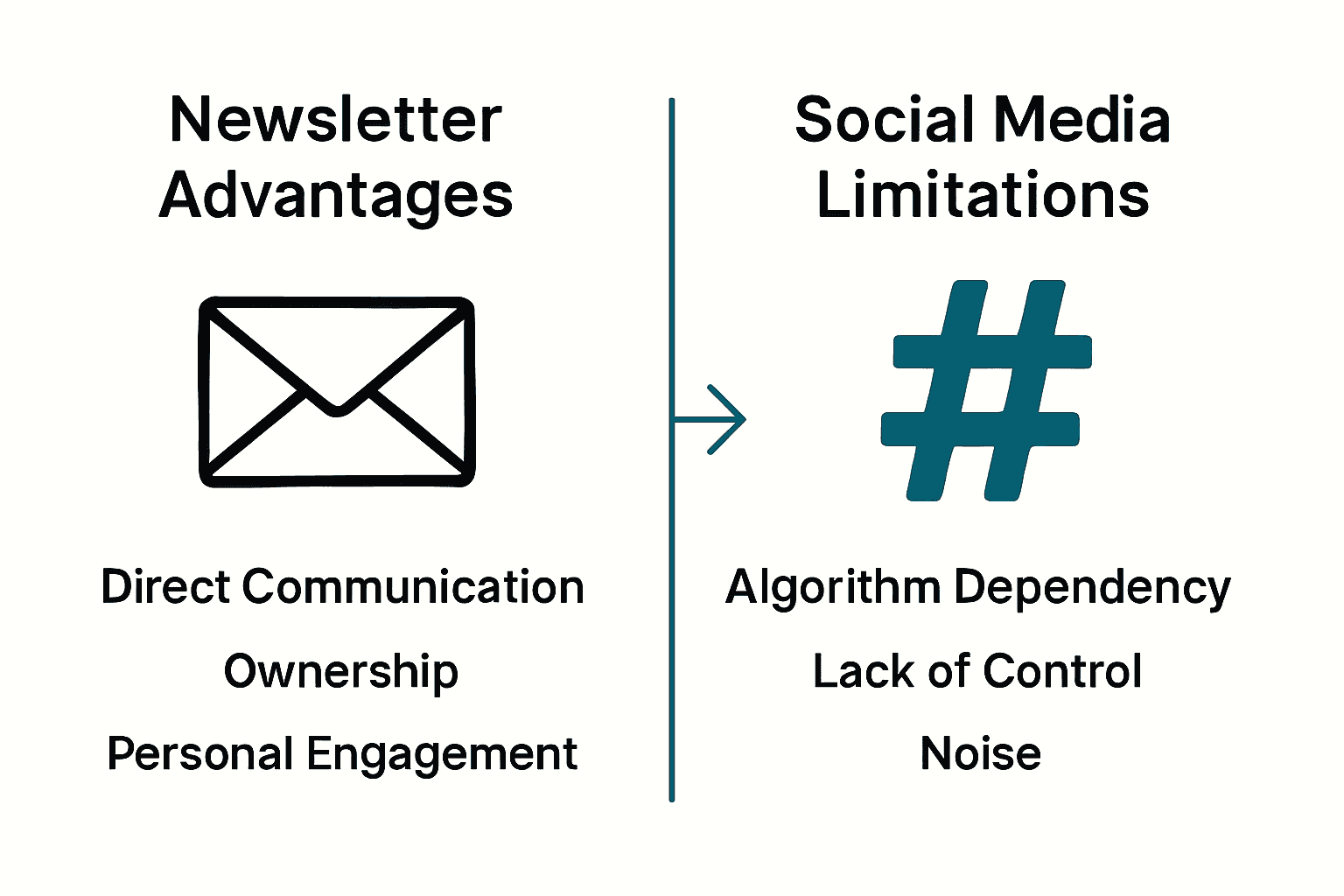
Types of Author Newsletters and Differences
Author newsletters are not a one-size-fits-all communication strategy. According to research from Beehiiv, writers can craft newsletters in multiple distinct formats, each serving unique audience engagement goals. Understanding these variations allows authors to select the most effective approach for their specific writing genre and reader preferences.
The primary newsletter types for authors include:
Here’s a comparison of the main types of author newsletters:
| Newsletter Type | Main Focus | Best For |
|---|---|---|
| Curated | Links & Resources | Resource-hunting readers |
| Practical | How-to Tips & Techniques | Writers seeking actionable advice |
| Personality-Driven | Author’s Stories & Journey | Readers wanting personal insights |
| Analytical | Expert Analysis & Industry | Non-fiction or thought leaders |
| Inspirational | Quotes & Motivation | Writers needing encouragement |
- Curated Newsletters: Collections of carefully selected links, summaries, and recommended resources
- Practical Newsletters: Actionable how-to content and writing technique insights
- Personality-Driven Newsletters: Personal storytelling showcasing the author’s journey and worldview
- Analytical Newsletters: In-depth, long-form expert analysis and industry perspectives
- Inspirational Newsletters: Quote compilations and motivational content for writers
Research from Feather further elaborates on newsletter formats, highlighting that successful newsletters can range from weekly industry news digests to personal recommendation platforms. Each format offers distinct advantages: curated links provide quick value, tool roundups offer practical resources, and personal reflection newsletters build deeper reader connections.
The key is matching your newsletter style to your writing goals and audience expectations. A fiction author might leverage personality-driven newsletters to share character development insights, while a non-fiction writer could use analytical formats to demonstrate industry expertise. Your newsletter becomes an extension of your writing voice – a powerful tool for building a loyal, engaged readership.

How Newsletters Build Reader Communities
Community building through newsletters transforms passive readers into active, engaged participants in an author’s creative ecosystem. Modern digital platforms have revolutionized how writers connect with their audience, moving beyond traditional one-way communication models to create interactive, meaningful relationships.
According to research on community-building tools, platforms like Substack and Beehiiv now offer sophisticated features that enable authors to cultivate vibrant reader communities. These tools provide critical engagement mechanisms such as:
- Direct comment sections
- Integrated chat functionalities
- Referral program incentives
- Interactive discussion spaces
- Personalized reader feedback channels
Newsletters create a unique intimacy that social media cannot replicate. By delivering content directly to a reader’s inbox, authors establish a personal connection that feels more deliberate and meaningful. Readers aren’t just consuming content; they’re becoming part of an exclusive community that shares common interests, values, and literary passions.
The magic of newsletter community building lies in consistency, authenticity, and interaction. Successful authors use their newsletters not just as broadcast tools, but as conversation starters. They share personal stories, solicit reader opinions, offer behind-the-scenes glimpses into their writing process, and create a sense of belonging. This approach transforms readers from distant consumers into invested community members who feel personally connected to the author’s journey and creative vision.
Monetization Strategies for Indie Authors
Newsletter monetization represents a transformative opportunity for independent authors to generate direct revenue from their writing and audience relationships. According to research on Substack, modern digital platforms now provide sophisticated infrastructure that enables writers to earn income directly from subscriber contributions.
Independent authors can explore multiple monetization approaches:
- Paid Subscription Tiers: Offering exclusive content at different price points
- Sponsorship Opportunities: Partnering with brands relevant to your audience
- Premium Content Sections: Gating advanced or in-depth material
- Affiliate Marketing: Recommending products with commission structures
- Digital Product Sales: Selling workshops, guides, or exclusive resources
The most powerful monetization strategy involves creating genuine value that readers are willing to pay for. This means developing high-quality, unique content that readers cannot easily find elsewhere. Successful authors understand that monetization isn’t about extracting money, but about providing exceptional insights, entertainment, or expertise that readers perceive as worth their investment.
Newsletters offer unparalleled advantages over traditional publishing models by providing direct financial connections between authors and readers. By cultivating a loyal audience and consistently delivering compelling content, indie authors can transform their newsletters from communication tools into sustainable revenue streams. The key is maintaining authenticity, understanding your audience’s needs, and continuously evolving your offering to provide exceptional value.
Common Newsletter Mistakes to Avoid
Newsletter failures often stem from overlooking critical design and communication principles that separate engaging content from forgettable emails. According to research from Letterbucket, authors frequently stumble into predictable traps that can dramatically reduce reader engagement and newsletter effectiveness.
The most prevalent newsletter mistakes include:
- Weak Subject Lines: Failing to create compelling, curiosity-driving headlines
- Irregular Scheduling: Inconsistent publication times that confuse readers
- Lack of Audience Segmentation: Treating all subscribers as a monolithic group
- Excessive Self-Promotion: Overwhelming readers with constant sales pitches
- Poor Design and Mobile Optimization: Unreadable layouts across devices
- Missing Clear Calls to Action: Leaving readers uncertain about next steps
- Ignoring Performance Metrics: Not analyzing what content truly resonates
Research from Kasplo further highlights the importance of personalization and tone. Successful newsletters avoid robotic, impersonal language and instead create a conversational, authentic connection. The key is balancing professional insights with a genuine, approachable writing style that makes readers feel like they’re receiving a personal communication from a trusted friend.
Ultimately, avoiding these common pitfalls requires thoughtful, strategic approach to newsletter creation. Authors must view their newsletter as a relationship-building tool, not just a broadcasting channel. By prioritizing reader experience, consistently delivering value, and remaining adaptable to audience feedback, writers can transform potential mistakes into opportunities for deeper reader engagement.
Turn Your Newsletter Into a Profitable Reader Magnet
Are you finding it difficult to build real connections and sell more books despite your best efforts with newsletters? Many writers struggle with inconsistent engagement, weak community building, and newsletters that just do not translate to real results. The article highlights the importance of audience ownership, clear calls to action, and engaging content. But the path from recognizing these issues to launching a loyal, buying reader base often feels overwhelming.
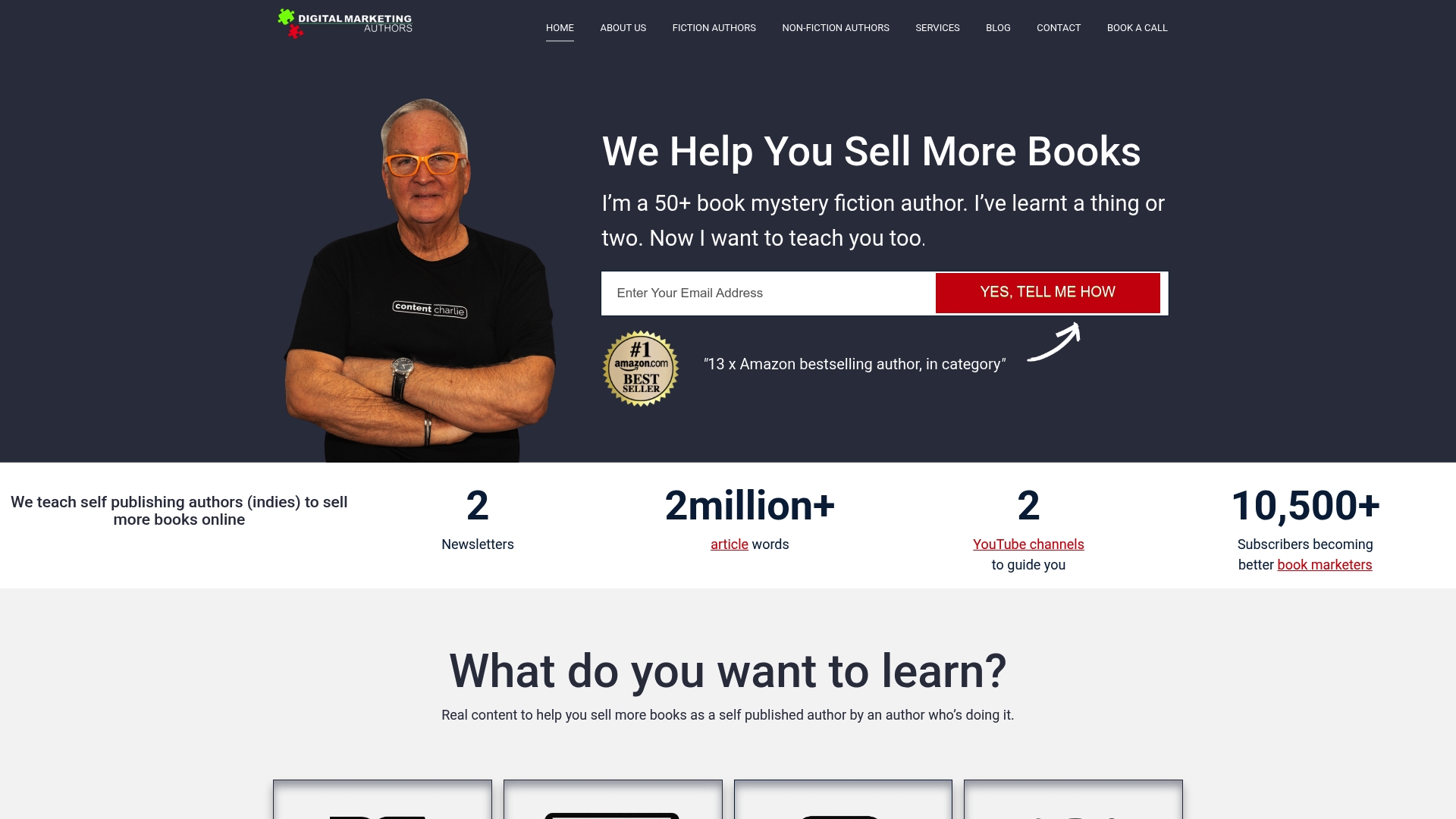
You do not have to figure this out alone. At Digital Marketing Authors, you will discover step-by-step systems that take your newsletter from forgettable to unmissable. We show you how to automate your author brand, grow devoted reader communities, and turn every email into a revenue opportunity. If you are ready to stop guessing and start building your own profitable audience, visit Digital Marketing Authors and take your writing career to the next level now.
Frequently Asked Questions
What is the purpose of a newsletter for writers?
A newsletter allows writers to communicate directly with their audience, sharing curated content, insights, book promotions, and fostering a loyal reader community.
What types of newsletters can authors create?
Authors can create various types of newsletters, including curated, practical, personality-driven, analytical, and inspirational, each serving unique engagement goals.
How can newsletters help build a reader community?
Newsletters facilitate community building by transforming passive readers into engaged participants, creating a personal connection through direct communication and fostering interaction and feedback among subscribers.
What are effective monetization strategies for indie authors using newsletters?
Indie authors can monetize their newsletters through paid subscription tiers, sponsorship opportunities, premium content sections, affiliate marketing, and digital product sales, focusing on providing unique value to their audience.
Recommended
- author newsletter Archives – DigitalMarketingAuthors.com
- Author Newsletter Archives – DigitalMarketingAuthors.com
- publish an author newsletter Archives – DigitalMarketingAuthors.com
- author newsletter publishing Archives – DigitalMarketingAuthors.com
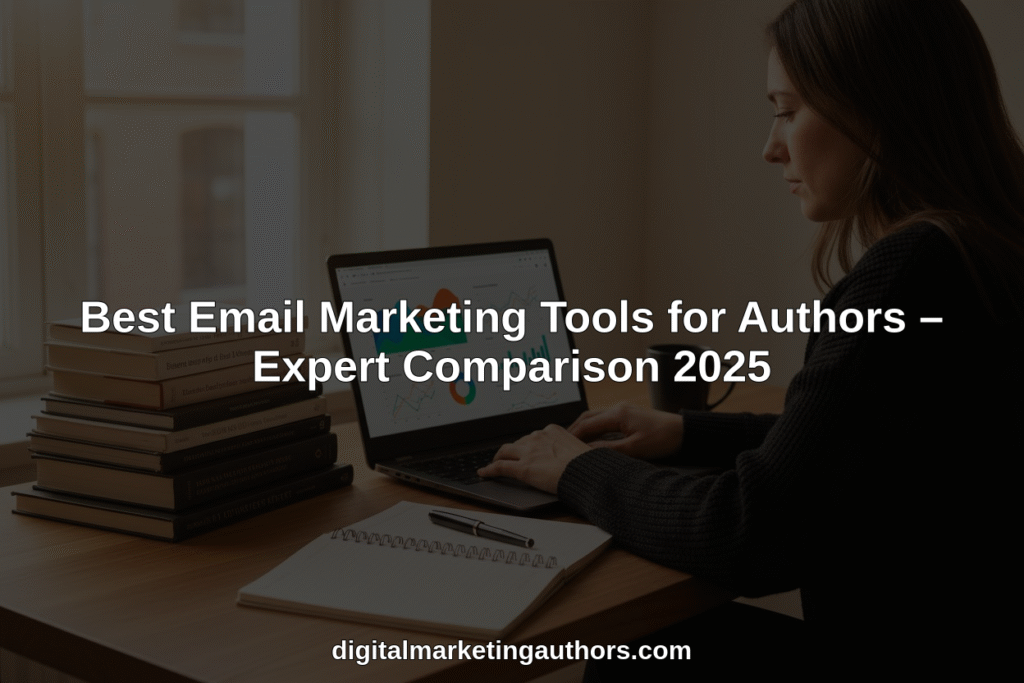
Best Email Marketing Tools for Authors – Expert Comparison 2025
Every writer looking to share their work faces the challenge of reaching readers and staying ahead of changing trends. There are many ways to grow an audience, build lasting relationships, or get real help with writing and publishing goals.
Some people prefer simple tools for sending emails or running promotions.
Others want expert advice, a supportive community, or new ways to connect with fans. The different options can feel overwhelming but each one brings its own style and practical benefits. Curious about which approach might fit your journey best?
Table of Contents
Digital Marketing Authors
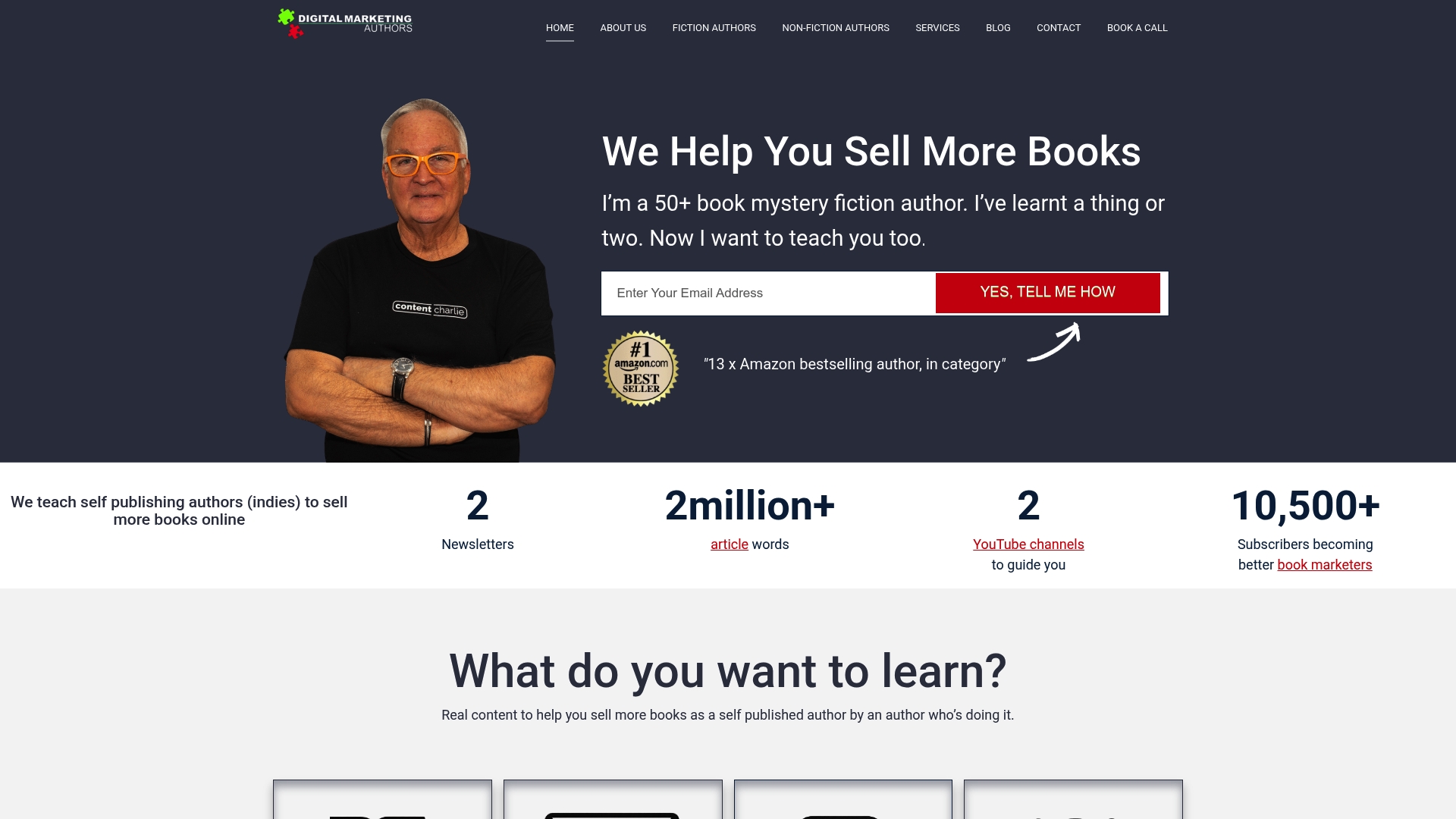
At a Glance
Digital Marketing Authors is a practical, author-focused resource that helps self-published writers sell more books using clear marketing methods.
Founded and led by Greg Reed, the site emphasizes email marketing, social media, and emerging AI tactics tailored for indie authors.
If you want straightforward strategies to grow a reader list and automate sales without relying on traditional publishers, this site gives actionable direction and inspiration.
Core Features
Digital Marketing Authors bundles concise, experience-driven guidance on email marketing, social media marketing, and AI marketing specifically for authors. The site teaches how to build a loyal reader community (a “reader army”), craft newsletter content that converts, and reinforce reader trust through consistent communication. Content formats include how-to articles, publishing tips, and strategic insights drawn from Greg Reed’s background as an author and marketing specialist. Note the site leans toward strategy and big-picture frameworks rather than step-by-step software tutorials or price-comparison guides, which is a deliberate focus on mindset and campaign design over product sales.
Pros
- Practical, experience-based advice: The guidance is grounded in real author experience, which means recommendations are relatable and immediately usable by working writers.
- Designed for self-publishing authors: Every tactic targets indie authors’ needs, from list-building to low-cost promotions, so you won’t waste time on irrelevant corporate marketing fluff.
- Includes modern AI marketing strategies: The site covers up-to-date approaches that help authors save time and scale outreach when used responsibly.
- Strong focus on reader trust and engagement: Emphasis on relationship-building helps authors turn casual readers into repeat buyers and long-term fans.
Who It’s For
This resource is ideal for self-published and indie authors who want to take control of their marketing. If you’re an author building your first newsletter, scaling a modest backlist, or trying to convert social followers into buyers, the site gives clear strategic direction. It’s especially useful for authors who prefer learning tactics and workflows rather than buying a single plug-and-play platform.
Unique Value Proposition
Digital Marketing Authors stands out because it translates book marketing into author-friendly tactics that actually map to publishing goals: more signups, stronger reader loyalty, and repeat sales. Unlike generic marketing blogs, every recommendation ties back to book discovery and purchase behavior. The combination of email-first thinking, social amplification, and pragmatic AI use creates a cohesive path from audience building to consistent revenue — a major advantage for independent writers who need repeatable, low-cost systems rather than one-off hacks.
Real World Use Case
An indie novelist follows the site’s newsletter templates and list-growth tips, then combines scheduled social posts with targeted email sequences. Over a few months, the author grows a mailing list, primes readers with trust-building content, and launches a discounted backlist promotion that yields measurable spikes in book sales and reviews.
Pricing
Not specified on the website.
Website: https://digitalmarketingauthors.com
MailerLite
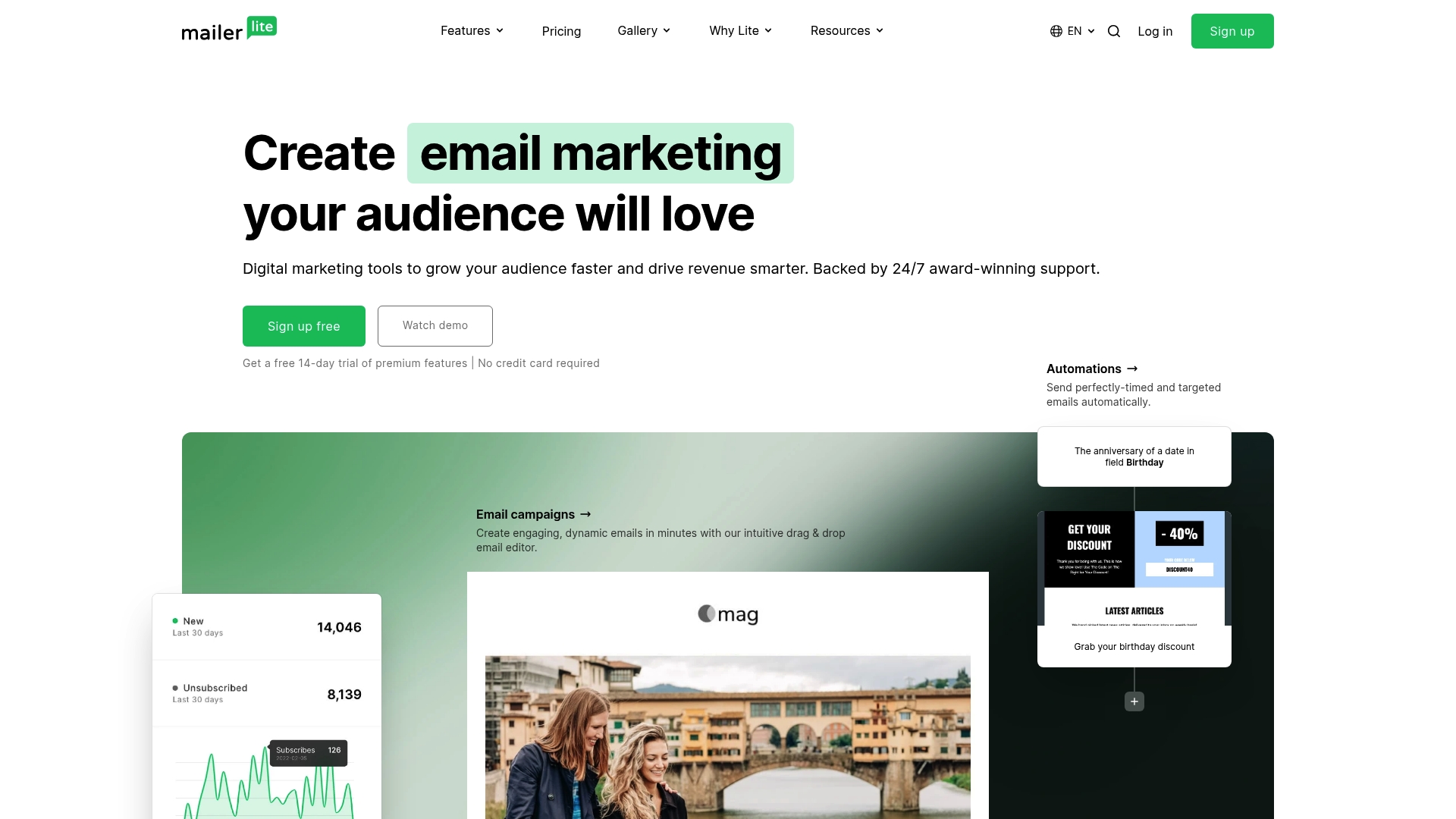
At a Glance
MailerLite is a clean, approachable email marketing platform built for creators, small businesses, and indie authors who want powerful features without the clutter. Its drag-and-drop editor, landing page builder, and automation tools make it easy to launch campaigns and grow a list quickly. The free tier (up to 500 subscribers) and attentive support lower the barrier for authors starting out. Expect limitations on advanced automation and subscriber caps unless you move to a paid plan.
Core Features
MailerLite combines core email marketing capabilities with website-building tools so you can run campaigns from a single dashboard. You get a drag-and-drop email editor, automations for targeted sequences, templates for emails and landing pages, signup forms and pop-ups, and tools to sell digital products and manage subscriptions. The platform also includes integrations with common web apps like Shopify and WooCommerce, A/B split testing, personalization options, and advanced analytics and reporting to track campaign performance.
Pros
- User-friendly interface: The platform’s simple, beautiful UI helps you build campaigns quickly without a steep learning curve.
- Robust automation and segmentation: MailerLite provides automation workflows and segmentation tools that let you send targeted, timely emails to different reader groups.
- Flexible plans including a free tier: You can start for free with up to 500 subscribers, which is ideal for authors testing email marketing before committing.
- Excellent customer support: The service is known for attentive support, which is helpful when you’re setting up automations or troubleshooting deliverability.
- Wide range of integrations and templates: Ready-made templates and integrations with e-commerce platforms simplify selling books or digital products directly from campaigns.
Cons
- Limited automation steps in lower-tier plans: Lower-cost plans restrict the number of automation steps available, which can hamper more complex author funnels.
- Advanced features require paid plans: Several advanced capabilities and higher subscriber limits are gated behind paid tiers, so you may outgrow the free plan quickly.
- Subscriber limit can cause automatic tier upgrades when exceeded: If your list grows past plan limits, MailerLite can trigger an automatic upgrade, which may lead to unexpected costs.
Who It’s For
MailerLite is ideal for indie authors, self-published writers, and small-to-medium creators who want a straightforward platform to build a reader list, run promotional campaigns, and sell digital products without hiring technical help. If you value ease-of-use, built-in landing pages, and a friendly support team, MailerLite fits well.
Unique Value Proposition
MailerLite’s strength is combining a clean, beginner-friendly interface with enough advanced features—like automations, landing pages, and product selling—to serve authors as they scale. The free entry point and variety of templates help you get campaigns live fast while integrations let you connect sales channels as your audience grows.
Real World Use Case
A small ecommerce store (or an indie author selling ebooks) uses MailerLite to run promotional campaigns, automate welcome and post-purchase emails, and grow its subscriber base via signup forms and landing pages—turning casual readers into repeat buyers.
Pricing
Starting at free (up to 500 subscribers); paid plans from $10/month for larger lists and more features.
Website: https://mailerlite.com
ConvertKit
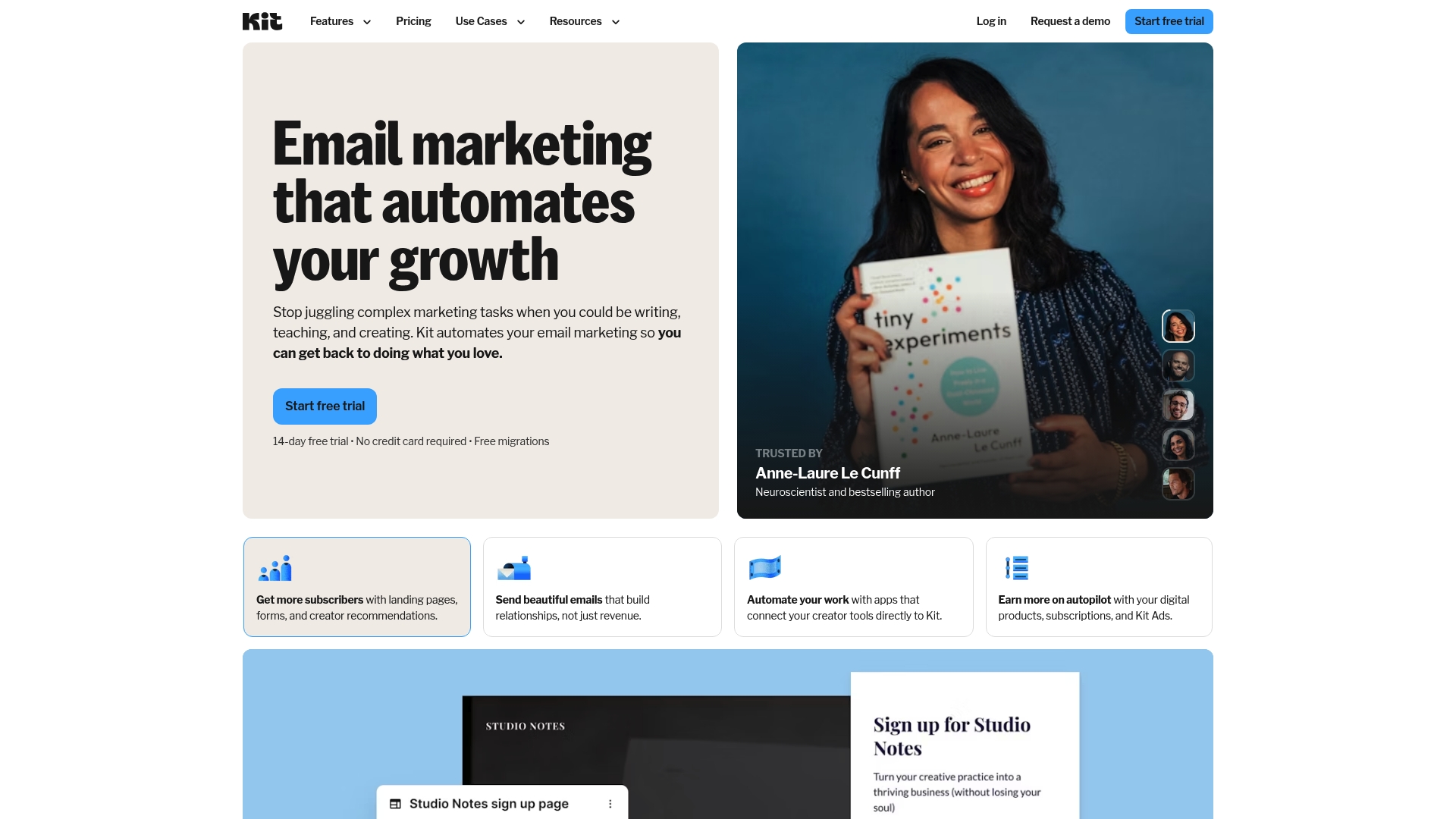
At a Glance
ConvertKit is an email marketing platform built for creators, authors, and small teams who want a straightforward way to grow audiences, automate outreach, and sell digital products or subscriptions. It combines landing pages, forms, tagging, and visual automations in a single interface that’s easy to pick up. If you want reliable deliverability and creator-focused monetization tools without a steep learning curve, ConvertKit is a strong, practical choice. It’s not the most customizable enterprise solution, but it gives most creators exactly what they need to build and monetize an audience.
Core Features
ConvertKit includes unlimited landing pages, forms, and email broadcasts, plus audience tagging and segmentation to organize readers. Its visual automation and email sequence builder make it simple to map onboarding and nurture flows. You can create landing pages and basic websites inside the platform and personalize messages using Liquid-style dynamic content for targeted messaging. The package is intentionally integrated so authors can switch between list growth, automation, and selling without stitching multiple tools together.
Pros
- Easy-to-use interface tailored for creators: The platform keeps common tasks simple, so you can focus on writing and audience-building rather than tool setup.
- Includes landing pages, forms, and automation tools in one platform: You won’t need separate tools to capture emails, build sequences, and host basic landing pages.
- High email deliverability rate (99.8%): Your messages are more likely to reach readers’ inboxes, which matters when every launch email counts.
- Provides free migration from other platforms: Moving your list in is less painful, helping you avoid migration friction when switching systems.
- Flexible pricing plans suitable for different sizes of creator businesses: There’s a free tier and graduated paid plans so you can scale as your list grows.
Cons
- Limited customizability compared to some larger platforms: If you need deep template control or highly specialized email layouts, ConvertKit’s design flexibility can feel constrained.
- Some advanced automation features available only in higher-tier plans: Full automation depth requires upgrading, which may surprise growing creators on a budget.
- Experience with larger or more complex businesses might find limitations in automation depth: Enterprise-level teams may hit feature ceilings as their workflows become more intricate.
Who It’s For
ConvertKit is ideal for creators, authors, educators, and small business owners who want an email tool designed around content and community. If you publish books, run newsletters, sell courses or memberships, and prefer a clean interface with built-in landing pages and monetization, ConvertKit fits well.
Unique Value Proposition
ConvertKit’s unique value is bundling creator-friendly list building, tagging, visual automations, and monetization into one platform with best-in-class deliverability. It emphasizes speed and simplicity so creators can convert attention into revenue without technical overhead.
Real World Use Case
A digital marketing coach used ConvertKit to set up automated onboarding sequences and landing pages, which helped increase their email subscribers by 100,000 through targeted forms and personalized campaigns — demonstrating how ConvertKit scales list growth and nurtures readers into buyers.
Pricing
Starting at Free plan for up to 10,000 subscribers; paid plans start at $33/month for up to 1,000 subscribers (Creator), with higher tiers adding features and subscriber limits.
Website: https://convertkit.com
Reedsy
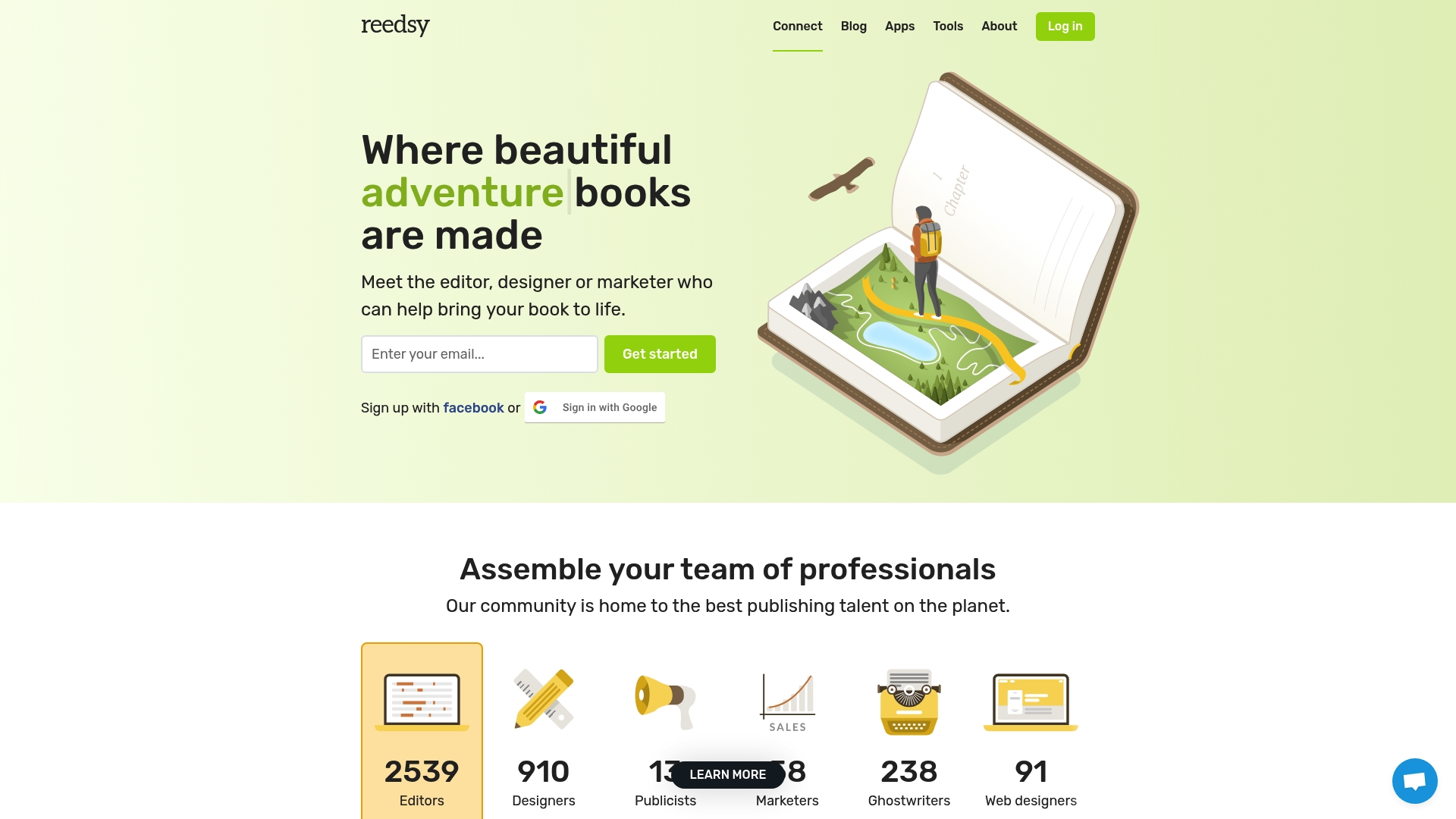
At a Glance
Reedsy is a curated marketplace that connects authors with professional editors, designers, marketers, publicists, and other publishing specialists. It pairs a searchable directory of vetted professionals with basic collaboration and project management tools, plus free educational courses for authors. If you need to hire specialists for specific stages of your book journey, Reedsy makes finding and managing those relationships straightforward — though you should expect to pay per service and verify quality case-by-case.
Core Features
Reedsy’s core strengths are its marketplace and the practical collaboration tools built around it. Authors can browse profiles and portfolios for editors, designers, marketers, and more, request quotes, and manage conversations and files through an integrated messaging and project management interface. The platform also offers free educational courses on writing, self-publishing, and marketing, helping authors level up while they hire professionals. In short: search, hire, and collaborate in one place, with resources to help you make informed choices.
Pros
- Access to a wide network of experienced publishing professionals: Reedsy brings many specialized roles together so you can find editors, cover designers, and marketers without hunting across multiple sites.
- Streamlined collaboration and communication tools: Built-in messaging, file sharing, and basic project management reduce the friction of working with remote freelancers.
- Educational resources for authors: Free courses on writing and publishing help you learn the process and ask smarter questions when hiring.
- Ease of finding and hiring specialists for different stages of publishing: Whether you need copyediting, a cover, or a publicity plan, you can source each role from one marketplace.
- Support for various roles including editing, design, marketing, and more: The breadth of professional categories makes Reedsy useful across an entire publishing timeline.
Cons
- Potential costs associated with hiring professionals and services: Most services are paid per project, which can add up depending on the quality and scope you choose.
- Dependence on the platform’s professional quality, which may vary: While profiles and portfolios help, the level and consistency of work can differ between freelancers.
- Limited information on pricing structures for services: Reedsy doesn’t list standardized prices, so you’ll often need to request quotes and compare proposals to understand total costs.
Who It’s For
Reedsy is ideal for authors at any stage who want professional help but prefer to manage the process themselves. Indie authors, self-publishers, and writers transitioning from traditional publishing will find it especially useful when they need vetted freelancers for discrete tasks like editing, cover design, or book marketing.
Unique Value Proposition
Reedsy combines a specialized marketplace with practical collaboration tools and educational content, making it a one-stop platform for authors who want to hire professionals while staying in control of their projects.
Real World Use Case
An author uploads a manuscript excerpt to browse editors, requests quotes from two promising candidates, hires one for a developmental edit, then contracts a cover designer and a marketing specialist through the same platform to prepare the book for launch.
Pricing
Quote-based: Pricing is not specified on the platform and typically involves paying for professional services requested through Reedsy.
Website: https://reedsy.com
Author Marketing Group™
At a Glance
Author Marketing Group™ is a membership-focused support network designed to help authors expand their reach, increase book sales, and grow their professional influence. It mixes community connection, virtual mastermind sessions, and a curated directory of marketing professionals and resources. If you want collaboration, peer feedback, and access to vetted services in one place, this group delivers a clear membership-oriented framework. However, you should be prepared to ask questions about costs and specific program outcomes before committing, since public details are high level.
Core Features
Author Marketing Group™ centers on three core capabilities: a global community for author-to-author connection and collaboration, virtual mastermind groups that provide structured learning and creative growth, and a curated collection of marketing professionals, services, platforms, and resources exclusive to members. These pieces are positioned to guide authors from idea through publication and into ongoing promotion, combining peer support with professional referral options rather than a single all-in-one software tool.
Pros
- Access to a global community for support and collaboration: Members can connect with authors and supporters worldwide to share feedback, strategies, and encouragement.
- Opportunities for growth through mastermind groups and events: Regular virtual masterminds provide structured spaces for learning, accountability, and creative development.
- Curated marketing resources and services exclusive to members: The group offers a vetted directory of professionals and platforms to help authors find targeted marketing help.
- Focus on helping authors increase impact, influence, and income: The stated mission clearly targets measurable author goals—visibility, sales, and professional growth.
- Potential for networking with professionals and other authors worldwide: The community model facilitates introductions to industry professionals and cross-promotional opportunities.
Cons
- Information provided is promotional and broad, lacking specifics on individual programs or services: The public description emphasizes benefits but does not list concrete curricula, tools, or deliverables.
- Details on costs, membership fees, or commitment are not specified: You cannot determine value or budget impact from the site alone and will need to request pricing.
- No immediate details on the scope or success stories of the group, requiring further inquiry for clarity: The absence of clear case studies or measurable outcomes makes it harder to predict how the group will perform for your specific goals.
Who It’s For
Author Marketing Group™ is best for authors and entrepreneur-authors who want community-driven support rather than a standalone email platform or do-it-yourself marketing course. If you value peer accountability, curated professional referrals, and virtual mastermind learning, this membership model fits. It’s especially useful for authors ready to invest time in networking and to follow through on collaborative marketing efforts.
Unique Value Proposition
The group’s unique offer is its blend of community accountability plus access to a curated marketing ecosystem. Instead of selling tools or single services, it packages connection, learning, and vetted referrals to help authors navigate promotion from concept to market impact.
Real World Use Case
An author joins to attend mastermind calls, receives feedback on a launch plan from peers, and hires a recommended marketing professional from the member directory to run targeted promotions—resulting in clearer strategy and coordinated outreach across channels.
Pricing
Not specified on the website.
Website: https://authormarketinggroup.com
Digital Marketing Tools for Authors Comparison
This table provides a concise summary of various digital marketing tools and resources tailored for authors. Compare features, pros, cons, and pricing to choose the right platform that fits your self-publishing and marketing needs.
| Platform | Key Features | Pros | Cons | Pricing |
|---|---|---|---|---|
| Digital Marketing Authors | Focused on email, social media, and AI strategies for authors | Practical advice, designed for self-publishing, includes AI strategies, reader engagement focus | Strategy over step-by-step guides | Not specified |
| MailerLite | Email marketing platform with drag-and-drop editor, landing pages, automations | User-friendly, robust automation, free plan for up to 500 subscribers, good support | Limited free tier automation, advanced features gated, possible unexpected cost upgrades | Free up to 500 subscribers; $10/mo+ |
| ConvertKit | Email and audience building with landing pages, forms, and automations | Easy to use, high deliverability, free migration, flexible pricing | Limited customization, some features in higher plans | Free up to 10,000 subscribers; $33/mo+ |
| Reedsy | Marketplace for hiring publishing professionals, collaboration tools | Access to publishing experts, streamlined communication, educational resources | Service costs can add up, variability in service quality | Quote-based, pricing unspecified |
| Author Marketing Group™ | Membership for author networking, masterminds, marketing resources | Global community, growth through masterminds, curated resources | Broad program details, unspecified costs, lack of clear success stories | Not specified |
An author joins to attend mastermind calls, receives feedback on a launch plan from peers, and hires a recommended marketing professional from the member directory to run targeted promotions—resulting in clearer strategy and coordinated outreach across channels.
Stop Letting Your Emails Get Ignored – Start Building Real Reader Loyalty Now
It is discouraging when your email marketing feels like it is being sent out into the void. The article “Best Email Marketing Tools for Authors – Expert Comparison 2025” highlights how indie authors struggle to transform mailing list signups into loyal book buyers and repeat fans. Many writers feel overwhelmed choosing the right platform, fall behind on automating sequences, or watch book sales stall after launches. You want a practical path from collecting emails to growing a true reader community that actually converts.

This is where Digital Marketing Authors comes in. Founded by 13x #1 Amazon bestselling author C.T. Mitchell, we teach you how to build trust and automate sales using proven email and AI strategies, just like the ones reviewed in this article. Learn how to craft engaging welcome emails, nurture true fans, and launch new books with confidence. Visit our homepage to start turning your mailing list into your most valuable asset. Ready to market smarter and sell more books right now? Take action and transform your author business today.
Frequently Asked Questions
What are the most important features to look for in email marketing tools for authors?
To effectively engage with readers, look for features like automation workflows, list segmentation, and customizable templates. These capabilities help you target specific reader groups and streamline your communication efforts.
How can I grow my email list as an author using these tools?
You can grow your email list by integrating signup forms on your website and sharing links through your social media channels. Aim for an increase of 50 to 100 new subscribers within the first month by running targeted promotions.
What strategies can I use for effective email marketing campaigns?
Consider building a welcome series for new subscribers and sending regular newsletters with exclusive content or offers. By establishing a consistent schedule, you can foster reader loyalty and boost engagement over time.
How often should I send emails to my subscribers without overwhelming them?
Generally, sending emails every 2-4 weeks is a good balance to maintain engagement without causing fatigue. Start by planning a monthly newsletter and evaluate reader feedback to adjust frequency accordingly.
What type of content should I include in my author newsletter?
Your newsletter can feature book updates, behind-the-scenes insights, reader exclusives, and links to upcoming events or promotions. Providing value in each email can help increase reader retention and interest.
How can I track the effectiveness of my email marketing campaigns?
You should monitor open rates and click-through rates to evaluate campaign success. Set measurable goals for each campaign, aiming to improve these rates by around 10-15% with consistent analysis and adjustment.
Recommended

Profitable Email Marketing Strategy
A Profitable Email Marketing Strategy That Authors Can Bank On
Email marketing is a powerful tool for authors to connect with their audience, boost book sales, and build long-term relationships with readers. Let’s delve deeper into crafting a profitable email marketing strategy that can take your author business to the next level.
Why Email Marketing Matters for Authors
Email marketing isn’t just another tool—it’s a direct line to your audience. Here’s why it’s critical for authors:
- Direct Access to Readers: Unlike social media, where algorithms decide who sees your content, email allows you to communicate directly with your subscribers.
- High ROI: Studies consistently show that email marketing delivers one of the highest returns on investment (ROI) in digital marketing.
- Builds Reader Loyalty: Regular email communication helps foster a loyal community of readers who will eagerly await your next book.
What Makes a Profitable Email Marketing Strategy?
1. Permission-Based Communication
The foundation of an effective email marketing strategy is building a list of people who want to hear from you. Here’s how to get started:
- Use an Opt-In Form: Create a simple form on your website where visitors can subscribe.
- Offer an Incentive: Attract subscribers by offering something valuable, like a free short story, exclusive content, or a discount on your books.
2. Build Multiple Lists
Segmenting your email list allows you to send more relevant messages. Create at least two lists:
- Buyers: These are readers who have already purchased your books. Send them updates on new releases, exclusive content, and offers.
- Non-Buyers: These are potential readers who haven’t yet made a purchase. Nurture them with engaging content that builds trust and interest in your work.
How to Create Value with Every Email
Readers won’t stay subscribed unless your emails consistently deliver value. Here’s how you can ensure every email resonates:
1. Share Exclusive Content
Reward your subscribers with content they can’t get anywhere else:
- Behind-the-scenes insights into your writing process.
- Sneak peeks of upcoming books.
- Deleted chapters or character backstories.
2. Provide Informational Pieces
Educate and entertain your audience with emails that go beyond promoting your books:
- Writing tips for aspiring authors.
- Interesting facts or trivia related to your book’s themes or setting.
- Book recommendations in your genre.
3. Create Sales-Driven Emails
Promotional emails should be carefully crafted to balance value and a clear call-to-action:
- Announce new book releases or limited-time discounts.
- Share glowing reviews or testimonials about your books.
- Include links to your books on Amazon or your website for easy purchasing.
Don’t Let Website Visitors Slip Away
1. Capture Non-Buyers
Most visitors to your site won’t purchase during their first visit. Use these strategies to turn them into subscribers:
- Offer a free download, such as the first chapter of your book or an exclusive short story.
- Create a compelling call-to-action like: “Sign up for updates and get exclusive access to my next book before it’s released!”
2. Retarget Your Audience
Once they’re on your email list, use regular updates to bring non-buyers back to your website, keeping your books top-of-mind.
Best Practices for Email Marketing Success
1. Use a Reliable Email Marketing Platform
Platforms like Mailchimp, ConvertKit, or MailerLite offer tools to automate emails, segment lists, and track performance metrics. I use Getresponse.
2. Personalize Your Messages
Use your subscriber’s name and tailor content to their preferences. Personalization increases open rates and engagement.
3. Track and Optimize
Monitor key metrics such as open rates, click-through rates, and conversions. Use this data to refine your email strategy.
4. Stay Consistent
Decide on a regular schedule—weekly, biweekly, or monthly—and stick to it. Consistency builds trust and keeps your readers engaged.
Conclusion: A Strategy You Can Bank On
Email marketing is a proven way for authors to grow their audience, boost book sales, and establish lasting connections with readers. By creating value with every email, segmenting your audience, and nurturing both buyers and non-buyers, you can craft a strategy that truly transforms your author business.
📬 Start building your email list today and unlock the full profit potential of your writing career!

6 Winning Keys To Business To Business Email Marketing
6 Winning Keys to Business-to-Business (B2B) Email Marketing

4 Ways To Build Your Reader’s Trust Quickly
4 Ways To Building Reader Trust: The Key to Author Success
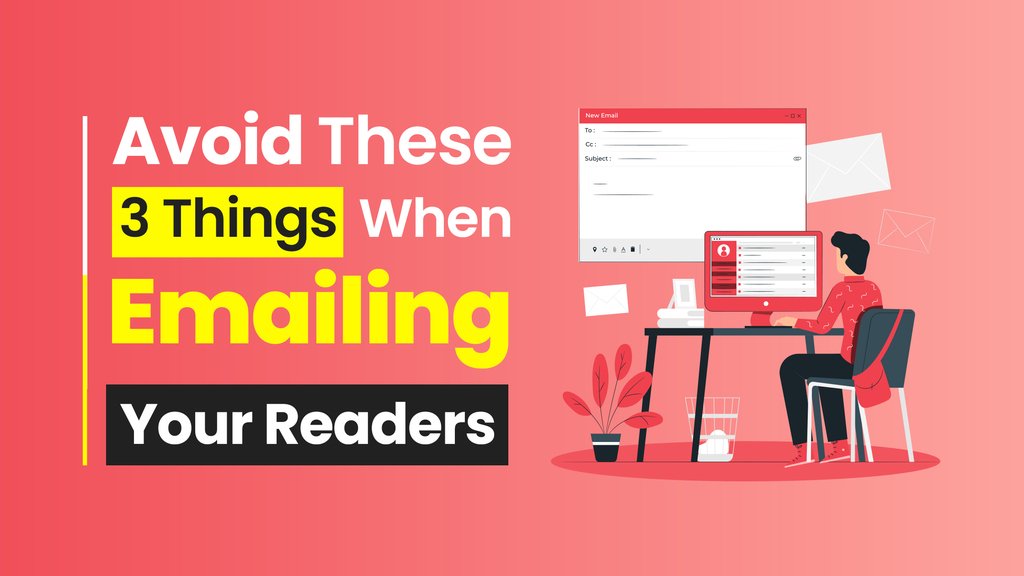
3 Email Marketing Mistakes For Authors To Avoid
3 Email Marketing Mistakes for Authors to Avoid
Building a successful email list is one of the most powerful tools an author can use to engage readers, promote books, and grow an audience. However, email marketing must be approached thoughtfully to ensure you maintain trust and provide value.
This article explores three major mistakes authors should avoid when emailing their readers and offers actionable tips to keep your list thriving.
Why Your Reader List is Important
Your email list is a direct line to your most loyal readers. Unlike social media, where algorithms control visibility, email allows you to deliver content straight to your audience. A well-managed list:
- Builds Trust: Readers view you as a reliable and respectful communicator.
- Drives Engagement: Email newsletters can boost book sales, website visits, and overall reader interaction.
- Ensures Longevity: An engaged email list can provide consistent support throughout your author career.
To protect and grow this valuable asset, it’s essential to avoid common mistakes.
Mistake 1: Don’t Spam Your Readers
Respect Their Consent
Spamming is not only unethical but also illegal in many countries. Sending unwanted emails can damage your reputation, alienate your readers, and lead to legal consequences.
How to Avoid Spamming:
- Use Double Opt-In: Ensure subscribers confirm their email addresses before joining your list to guarantee they genuinely want to hear from you.
- Include an Unsubscribe Option: Every email should have a clear link for readers to opt out.
- Follow Email Laws: Familiarize yourself with regulations like the CAN-SPAM Act or GDPR to avoid fines and maintain compliance.
Pro Tip: Only email people who have explicitly subscribed to your list. Never buy email lists—it’s a surefire way to be labeled a spammer.
Mistake 2: Don’t Over-Sell
Balance Sales with Value
While the ultimate goal of your email list may be to promote your books, constantly bombarding readers with sales pitches can lead to disengagement and unsubscribes.
How to Strike a Balance:
- Provide Value First: Share exclusive content, writing tips, behind-the-scenes updates, or free resources.
- Use the 80/20 Rule: Dedicate 80% of your emails to engaging, non-sales content and 20% to promoting your books or services.
- Include Personal Touches: Write emails that feel conversational and relatable, building a genuine connection with your readers.
Pro Tip: Readers are more likely to support your work when they feel they’ve received value from you.
Mistake 3: Don’t Neglect Your Content Quality
Keep Emails Relevant and Professional
Your emails represent your brand as an author. Poorly written or irrelevant emails can harm your credibility and alienate readers.
How to Deliver High-Quality Content:
- Stick to Your Genre: If you write thrillers, don’t send emails about cooking recipes unless it ties directly to your books.
- Proofread Thoroughly: Ensure your emails are free of spelling and grammatical errors.
- Avoid Offensive Material: Never include shocking or controversial content that could upset your readers.
Pro Tip: Focus on content that enriches your readers’ lives, such as insights into your writing process, reading recommendations, or fun trivia about your books.
Bonus Mistakes to Avoid
1. Ignoring Bounce Rates
Monitor your email deliverability to ensure your messages reach your readers.
- Soft Bounces: Temporary issues like full inboxes or server errors.
- Hard Bounces: Permanent issues, such as invalid email addresses.
Regularly clean your list by removing invalid addresses to maintain high deliverability rates and avoid being flagged by email service providers.
2. Sending Emails Too Frequently (or Infrequently)
There’s no one-size-fits-all answer for how often to email your readers.
- Test different frequencies to find what works best for your audience.
- Provide consistent value to ensure readers look forward to your emails.
3. Forgetting the Reader-Centric Approach
Remember, your email list isn’t about you—it’s about your readers. Focus on what they want, not what you want to sell.
Conclusion: Build a Thriving Reader List
Email marketing can be a game-changer for authors, but only if approached with care and strategy. Avoid these common mistakes:
- Don’t spam: Respect your readers’ consent and privacy.
- Don’t over-sell: Focus on delivering value first and foremost.
- Don’t neglect content quality: Keep emails relevant, professional, and reader-centric.
By maintaining a clean, well-managed list and consistently providing valuable content, you’ll not only retain your current subscribers but also grow your reader tribe over time.
📧 Start nurturing your reader list today—build trust, deliver value, and see the results in your author business!

3 Fast Ways To Build A Profitable Author Opt-In List
The Author Opt-In List
You finally realize that you need a good author opt-in list. After reading countless articles and sought expert advices and have read many success stories of people creating a small fortune with opt-in lists you finally decide to have one of your own.
Then it happens, you think you have known everything there is to know about opt-in lists and have followed their advices to the T and you still weren’t able to make a profit.
Author Opt-In Lists Yhat Fail
In fact, you may be losing money. You maybe hiring writers to help you out, or there are some expenses incurred, even if you have a big list, but only a very small percentage actually buys from you, your still losing profit. You’ll realize this after a few months when you see your statistics and sales figures. How can you fix this?
So what could have gone wrong? Why have other authors succeeded where you have failed?
The most common mistake is that you dived straight right in.
No plan is your first problem. You chose a topic where you think could be quite popular and would earn you money. This just not the case. Just because you wrote to people from the list doesn’t mean they are going to buy instantly.
You didn’t do any research, in particular keyword research.
Keyword Research
Discovering what people are searching for is crucial for any business including your author business. Your business needs to be built around what people ACTUALLY want; not what you THINK they want.
I use two easy and free methods to discover what people are searching for.
a) Ubersuggest.com
A great free tool from Neil Patel that allows you to enter a keyword or keyword phrase into the search box and the top 100 choices appear including the volume of searches and their long form additions.
eg Author branding
How to build an author brand
Author branding for beginners
While long tail variations may have less volume, you will have an easier path to rank for these terms over the major keyword phrase you originally entered. Add these long tail phrases together and you’ll end up with considerable search volume. This is a great way to add to your author opt-in list.
b) Alphabet Soup Method
Simply go to the search bar on Google and type in your keyword; lets use author branding again.
Then after the term add the letter ‘a’.
A drop down list of the current search terms will appear. eg author branding article, author branding agency, author branding affiliate and so on. Usually about 6 or 7 suggestions drop down.
Do this for every letter in the alphabet. eg ‘b’ might show up author branding book, author branding best methods and so on.
By using the alphabet method you’ll usually create around 150 red hot, currently searched terms on Google. Boom!
A successful opt-in list requires preparation and planning. You must target who will be on your list, offer the right product or service THEY want and continue to serve that list as it grows.
Here I will offer more advice, for those who have started an opt-in list and have failed, you can rejuvenate your failed venture. For those who are starting, here are three quick and easy ways to build a profitable opt-in list.
3 Quick Ways For An Author Opt-In List

1) Get your customers to trust you and your products first. Just launching your opt-in list would not make you an expert and a believable selling author.
Put out many articles first before you start an opt-in list. Write about the topic you know and have started and used for your site. Use forums first to gain knowledge about your customers, about their wants and needs and target those wants and needs.
Join forums from other sites as well. Provide expert advice and recommendations. Build up your goodwill first, then you will be able to start your own opt-in list. You can build a base as well with other forum users. You can ask them to join your list. Friends are always good customers. Put up a link in your signature box to your site so that they may be able to see what you’re business is all about.
The fact is the money will only come in when the consumers and subscribers believe and trust in you. They want a product or service that could be a good exchange for their money. People are not going to buy something out of your recommendation if they don’t know you.
2) Find a product or service or build your own that people want and need. Although it may not be your forte, if you provide a service and product that you have researched and learned about well, you can develop moving forward. Invest your time, effort and money in what readers really want, not what you think they may want.
Do your research well and you will see the profits come in. Also provide your subscribers with promotional material that they could actually use and refer to others.
3) Make friends with other opt-in list users. This is basically beneficial especially if it is someone who has already launched a successful opt-in list. Engaging with your readers so they can like, know and trust you will build your author opt-in list and make it financially rewarding.
Experienced opt-in list users adopt the high engagement method. This doesn’t mean always selling something to your list. Build trust and the sales will follow.
Building a profitable opt-in list don’t just happen overnight. There is much preparation and effort to do. Author opt-in lists are built from scratch, as your list grows, you should also maintain the quality of your list. Keep it organized and manageable. Get or hire help if need be, just make sure that your subscribers are happy and satisfied and they will be willing to buy from you.
Conclusion
Having an author opt-in list is crucial if you want a financially successful author business. It allows you to build trust with your readers through engaging content. Give them exactly what they need. Add value to their reading experience.
Savvy author know to not always be selling. Give great content to your readers and sprinkle in a call to action for them to buy every now and then.
Continue to grow your list. It’s the greatest asset (besides your books) that an author will own. And remember you only ‘rent’ followers from social media channels. They own the followers and not you. Build your own author opt-in list!

